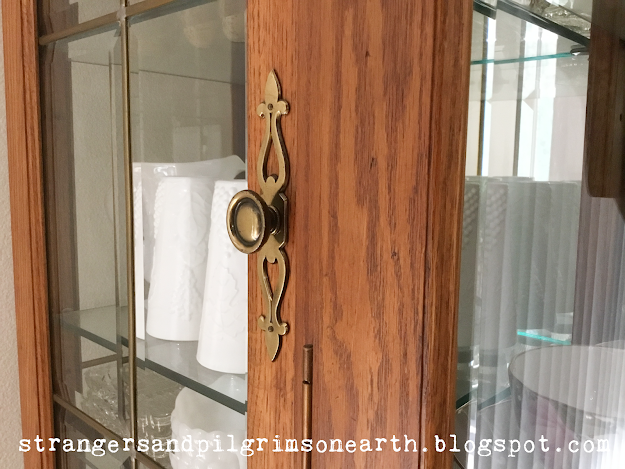"As cold waters to a thirsty soul,
so is good news from a far country."
~ Proverbs 25:25
Living for several years in a small foreign country with a struggling economy taught me many lessons about homemaking. Since moving back to the State's, I realize how my thought process has changed in many areas. Here is a list of 12 random, home-related things I gleaned while living abroad (and in no particular order)...
1. New Isn't Necessarily Better
This particular lesson shines in the subject of furniture. Most of the newer pieces sold in affordable stores are made up of particle board or MDF. Furniture made up of these compounds tend to wear down quicker due to the elements (were more susceptible to mold where we lived) and began to come apart with frequent moving. Plus, they can't withstand heavy loads and began to bow even though they are quite heavy themselves. I have also since learned that products made with particle board and MDF emits formaldehyde into the home - the very place you nurture to be a safe haven!
Furniture made with solid wood can be passed down to generations and is long lasting. Because of this, the locals would rather buy used furniture from auctions or estate sales rather than purchase from big box stores. The quality is what they were looking for. Money is scarce and long term use is most important. They want something they can pass down to their children as furniture is considered a family legacy.

Older wood furniture pieces have amazing bones. Most often they are very beautiful while boasting intricate carvings, ornate hardware and oftentimes glorious beveled glass! A helpful test to see if the quality of used (or new) furniture is good (besides the overall shape and appearance) is to look at the drawers. Is there dovetailing on the sides (this looks like a tongue-in-groove puzzle where the two sides of the drawers meet)? This shows quality craftsmanship.
When re-establishing our home, we opted to buy all used furniture (and to be honest, the budget also dictated this!). There was no way we could afford brand new solid wood furniture to last us a lifetime but thrift shops and Craig's List (and family members who were cleaning out storage units!) provided many affordable options for us that we also found visually appealing. Here in America I was amazed at the prices of solid furniture at Salvation Army Stores, Goodwills and Re-Stores. My foreign friends would be in shock at the vast assortment and budget friendly options!
If you are thinking about replacing your old but solid wood furniture, you may want to consider re-staining it, re-painting it, replacing the hardware to better suit your style or re-upholstering it as what you have is probably excellent and will be cherished in the years to come! I personally love the painted white look so any sturdy frame is fair game for our home making it less challenging to frugally furnish.
2. Repair When Possible
When something would break on our neighbor's farm or home, the first reaction would always be "repair". To purchase brand new was almost un-thinkable. If you remember the picture of the kitchen strainer I broke a few years back, my hubby fixed it with a piece of wire (this is the mentality of a non-consumer society). Handcrafted repairs reigned in the homes. Obviously, replacing broken parts from the manufacturer and so forth was routine. Knowing a good mechanic and repairman was gold. Everything that can be fixed was fixed until it couldn't be.
My Bosch mixer gave up the ghost while living out of the country. There were no retail stores even slightly nearby nor online shopping like we know in North America. Hubby took a look at it and it seemed like the transmission was the culprit. What to do? This was not an inexpensive part. We had to really weigh out the pros and cons (how old was the machine, was there a lot of life left, how much to buy brand new and have it imported, etc.). I used that machine daily to shred, blend, knead and slice. Perhaps in the old days I would have just replaced it. But at the time every penny counted. We decided to replace the part ourselves and hope we had troubleshooted accurately. And glory hallelujah it worked! We spend $150 instead of $500.
Here in America there is Amazon which delivers right to the door. There was no such thing where we lived. But what a convenience it is to simply type in a model number and find the parts and have them delivered the very next day! I do hope you take advantage of this possibility in your household.
3. Buy Good, Cry Once
When our neighbors finally had to replace something in their home or homestead, we were shocked to find that they purchased the very best quality when it appeared they had very little income to part with. The thought behind this was, instead of nickel and diming themselves to death, they were going to do it right the first time. Second, if they were going to replace something, it meant that it is something absolutely necessary for their lifestyle. They would not be spending money on anything frivolous to begin with. Thirdly, because of the importance of their purchase, they wanted to make sure that what they bought was going to last. They would check for plastic parts verses metal parts, where the item was made and if that country was known for good workmanship in that specific niche. Could they find replacement parts? These factors were all considered when making a purchase. Nothing was done lightly. They were spending hard earned money and they wanted to be prudent. They had very little but what they did have was "good".
Perhaps many of these concepts are already being employed by many of you but I thought I would share them just the same. I know that in my younger years I used to think that frugal meant buying the cheapest thing but I don't feel the same way about that now. I used to think that "brand new" had a longer life-span but I can see that isn't necessarily the case. I used to think repairs weren't worth the time and effort but if you are buying "good" in the first place then they absolutely are. What about you, what have you found to be helpful from your experiences with the topics above? Part two is shared HERE. Happy homemaking!














































